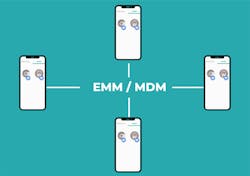This article originally appeared in the February 2025 issue of Security Business magazine. Feel free to share, and please don’t forget to mention Security Business magazine on LinkedIn and @SecBusinessMag on Twitter.
The Skinny:
-
Hypergate offers secure network access for mobile devices through a Kerberos Single Sign-On (SSO) solution, enabling seamless authentication with Active Directory.
-
Trend Micro & Intel's new partnership announced at CES integrates Intel's hardware detection capabilities with Trend Micro's AI-driven security platform, offering protection against advanced threats like fileless malware and ransomware.
-
Enterprise-Level Cybersecurity at CES: Both Hypergate and the Trend Micro-Intel collaboration provide innovative solutions tailored for enterprise IT managers and security directors.
While consumer-level cybersecurity solutions tend to garner the headlines at CES, we uncovered two enterprise-level solutions that should rpove interesting to IT managers and security directors. Here’s a closer look:
Hypergate – Secure Network Access via Mobile Device
Secure network access to an organization’s apps and infrastructure via mobile devices has long been a headache for IT and physical security directors; however, one CES exhibitor may have found a solution: Hypergate, a Swiss company we found in one of the two CES Switzerland pavilions. The company’s solution leverages an organization’s existing infrastructure to enable employees to access company resources on their smartphone like they are accustomed to on a computer.
Hypergate is a Kerberos Single Sign-On (SSO) solution for Android and iOS. With Hypergate Authenticator, users enjoy seamless login across mobile devices and apps. They can authenticate directly to Active Directory using personal or company smartphones, enabling authentication in both on-premise and hybrid environments.
Additionally, Hypergate Files enables users to access on-premise data on their mobile devices with the same user experience as a computer. All file types are supported by their native apps, so no special viewer, editor or custom implementation is required.
The key to the Hypergate solutions is an enterprise mobility management system (EMM), which many companies and organizations already have in place. Current supported EMMs include: Microsoft Intune, Ivanti Mobileiron, SOTI Mobicontrol, 42Gears, Samsung Knox, VMware Workspace ONE, BlackBerry UEM, KACE Solutions, and PushManager.
The EMM distributes Hypergate securely to company and/or personal smartphones and allows the organization to manage it. The solution runs only on the mobile devices and requires no cloud or other web services. Through a VPN, Hypergate then connects with the organization’s Active Directory securely – authenticating just once via password and/or biometrics. Once authenticated, Hypergate can open all the apps an organization deems necessary through the power of Active Directory. It also empowers users to reset and change their password directly on their devices.
Trend Micro and Intel Announce Collaboration
At CES, Trend Micro announced a new collaboration with Intel to help joint enterprise customers protect critical systems from stealthy threats, including fileless malware and advanced ransomware.
According to a press release, when Trend Micro's AI-powered Trend Vision One proactive security platform and Intel's technology are used together, the integrated solution can better determine if encryption behavior is legitimate – such as a user backing up files – or malicious, ensuring the appropriate action is taken to protect critical systems. The partnership creates powerful tools to detect and respond to ransomware and fileless attacks before they can cause damage.
"Threat actors are increasingly targeting endpoints with sophisticated attacks that evade traditional software-based security,” Intel VP Carla Rodriguez explained in the press release. “Trend Micro's integration of Intel Threat Detection Technology provides a hardware-accelerated detection layer to uncover these stealthy threats.”
Fileless attacks are particularly dangerous as they rely on in-memory execution, reside in the registry, or abuse legitimate tools like PowerShell and Windows Management Instrumentation.
About the Author
Paul Rothman
Editor-in-Chief/Security Business
Paul Rothman is Editor-in-Chief of Security Business magazine. Email him your comments and questions at [email protected]. Access the current issue, full archives and apply for a free subscription at www.securitybusinessmag.com.


